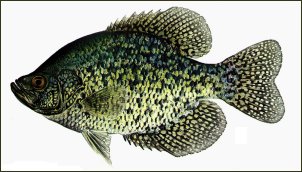New Hampshire’s Black Crappie - A Great Fish to Catch

Ok, it’s July and many anglers in the Granite State are still seeking out trout and salmon for action. Although the trout species are very popular among anglers in New Hampshire, warm water fish such as bass, pickerel, white perch, yellow perch, bluegill and black crappie also have their followers. One of my favorite warm water species to pursue is Pomoxis nigromaculatus, the black crappie. Pomoxis means shape or opercle (the gill cover) and nigromaculatus means dark spotted. These Latin words are what describe the black crappie, a beautiful, sporty and delicious eating fish. I was pleased to introduce my next door neighbor, Gerry McNeil, to fishing for black crappie last week. We caught 50 of them and released all but eight, which Gerry kept for a
meal. Now he’s looking forward to a repeat. “They were absolutely delicious,” he told me.

Pomoxis nigromaculatus, the black crappie.
The black crappie is said to have been illegally introduced into New Hampshire waters, many, many years ago. It
was found in Robinson Pond in Hudson; Scobie Pond in Londonderry; Horseshoe Pond in Merrimack and the Pennichuck Reservoir in Hollis. Until recent years, the New Hampshire Fish and Game Department hadn’t considered the black crappie worthy of being an important game fish species. However, as the popularity of this fish became quite evident among Granite State anglers, the Department finally decided to increase the availability of the black crappie. They began netting and introducing black crappie into other waters around the state.
Black crappie inhabit the weedy waters of lakes, ponds and rivers. They spawn in the Spring when water temperatures are between 58 and 64 degrees. The females, weighing about half a pound, will lay between 20,000 and 60,000 eggs. Adult fish may vary in length up to 12 inches, weighing a half pound. However, large specimens will weigh a pound or more and measure 15 to 18 inches. I have caught them in the 15 and 16 inch lengths.
The black crappie is a challenge to catch. They are light sensitive and generally stay at a certain level in the water column when feeding. Thus, it is important to find that depth and keep the bait or lure at that depth or slightly below if you want action. They will dive down for bait or lure but will rarely come up to take it.
A depth finder will be a big help to the angler for finding suspended crappies. However, if you don’t have one, try fishing at different levels until you find action. Crappies are a schooling fish and if you catch one, you will usually catch more. Also, crappies tend to bite gently, mouthing the bait or lure offered. Actually, they appear to inhale the bait or lure. I call it a kind of “vacuum” type action strike. Since they have large paper-thin mouths, which allows a hook to tear out easily, do not strike hard when a crappie nibbles the bait. If using live baits, minnows of no more than 1½ inches in length work best.
If you are still-fishing for crappies, lower your bait to just off the bottom. If you get no results, raise the minnow up a couple of feet and try that depth. If there are still no takers, come up a little higher and let the minnow swim there awhile. Keep doing this until you find the depth where crappies are active. Black crappies will also hit tiny spoons, jigs, spinner and worm combos and, yes, even flies. Lures and jigs should be jigged gently up and down very slowly. Adding a piece
of worm or mealworm to the jig or lure will generally result in more bites. Crappies aren’t the greatest fighter on the end of the line, unless they are of a large size. They usually wage a slow, short fight, giving up easily.
The black crappie is one of the tastiest pan fish known. You can bake or fry their fillets to your favorite fish recipe. I rank the black crappie even above the white perch and yellow perch for goodness, but all three are favorites of mine.
Today, there are numerous waters in the Granite State that contain good populations of black crappies These waters can be found in New Hampshire Fish and Game Department’s booklet, New Hampshire Freshwater Fishing Guide, which lists the water bodies by township and county and the fish species available in each listed lake, pond and river. Look for species #15 (black crappie). This booklet is available free from : Public Affairs Division, New Hampshire Fish and Game Department, 11 Hazen Drive, Concord, N.H. 03301. Or, call them at (603) 271-3211. Anglers should also obtain the 2009 edition of the New Hampshire Freshwater Fishing Digest. This booklet of rules is also available from the Department or license agents within the state.
Do be advised that, unlike past years, there is now a limit on black crappie, white perch, yellow perch and sunfish of 25 fish or a total daily combination of 50 fish. Over fishing of black crappie can and has taken its toll on this species in the state. According to southern fisheries biologists I have spoken with, crappie populations are very sensitive to over-fishing. Let’s not fish out a good thing. By all means, keep a few for a good meal and then practice catch and release. Enjoy this wonderful fish and tight lines!

Bob Harris can be
reached via e-mail at:
outwriter2@aol.com
Past
Columns by Bob Harris
>>>
About
Bob Harris
>>>
DISCLAIMER: The opinions
expressed by Mr. Harris are not necessarily those of the
Goffstown Residents Association or its members
Copyright©2009 Goffstown Residents Association. All Rights Reserved. |





